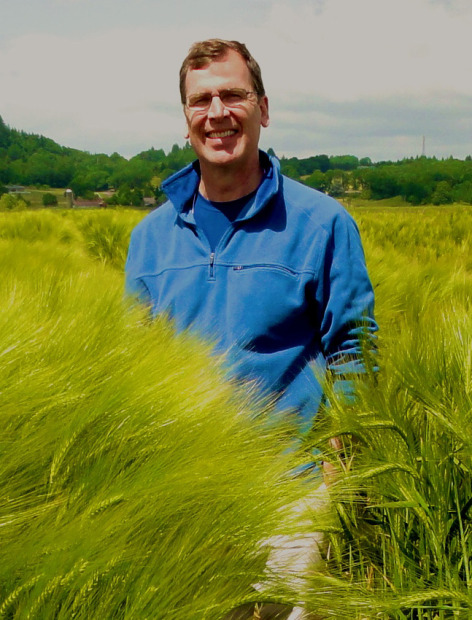Ames, Iowa, USA
May 8, 2014

Research led by a U.S. Department of Agriculture scientist at Iowa State University could improve the ability of crops to fight off diseases.
Roger Wise, a research geneticist with the USDA Agricultural Research Service and a collaborating professor in the ISU Department of Plant Pathology and Microbiology, leads the international project. The work was funded recently by a $2.5 million National Science Foundation (NSF)-Plant Genome Research Program grant to study the molecular mechanisms that determine the resistance of cereal crops to fungal pathogens.
In collaboration with investigators at Cornell, Indiana and the University of Florida, the four-year project will focus on how powdery mildew, a fungus that causes disease in a wide range of plants, impacts barley and wheat at the molecular level. The powdery mildew fungus can reduce crop yields by as much as 40 percent, Wise said. Other closely related powdery mildew fungi infect squashes, beans, strawberries, grapes, roses, and apple and oak trees, mostly in temperate climates.
Much of the research centers on effectors, or proteins secreted by the powdery mildew fungus that sabotage or weaken plant defense. The researchers will try to identify which specific molecular effectors act together with corresponding host plant targets to cause the disease. Wise said doing so requires testing around 40,000 molecular interactions. He said those experiments will be carried out with guidance from Dan Nettleton, the Laurence H. Baker Endowed Chair in Biological Statistics at Iowa State.
“Whenever a plant encounters a pathogen, there is a massive reprogramming of the plant’s survival mechanisms,” Wise said. “The host plant could be sitting there happily in the sunlight, with its genes working to make proteins required for normal growth. When a pathogen attempts to parasitize the host, whole sets of genes are reprogrammed to do new things. They either help defend the plant or they’re co-opted by the pathogen to suppress host defenses. So you’ve got thousands of genes doing things they wouldn’t do under optimal conditions.”
Identifying the molecular components that make cereal crops either susceptible or resistant to the powdery mildew will help plant breeders produce crops with desirable traits or help them eliminate harmful ones, he said.
The project draws on expertise from across the globe, including scientists at universities and research institutions in Germany, the Netherlands and the United Kingdom. In addition to the NSF funding, the collaboration is made possible by a joint grant from the European Research Area’s Coordinating Action in Plant Sciences (ERA-CAPS) program. This inaugural dual-funding structure, one of the first such collaborations between NSF and ERA-CAPS projects, pushes the total funding to around $5.5 million.
The project also has an outreach component that allows high school and community college science teachers to work in Wise’s lab during the summer and take what they learn back to their own classrooms. The outreach project, part of an NSF program called Research Experience for Teachers, is coordinated by Adah Leshem, ISU plant genomics outreach program director. The teachers receive lab equipment and access to online apps that help them apply lessons on genetics in their own curricula. The new NSF funds will be used to train teachers to help their students carry out molecular genetics experiments using a unique mutant barley population, Wise said.
“These plants exhibit exceptionally diverse and dramatic characteristics, so the kids really enjoy seeing these up close and learning how genes cause particular traits,” he said.
The grant also will enable these teaching resources to be implemented at Tuskegee University, one of Iowa State’s partner land-grant institutions.
In addition, ISU graduate students and postdoctoral researchers working on the project will have the opportunity to travel to Europe to work at the other contributing institutions for a few weeks at a time, Wise said. Likewise, European scientists will also travel to Iowa State regularly to exchange ideas.
“It’s a way for everyone to learn, stay on the same page and enhance the work,” Wise said.